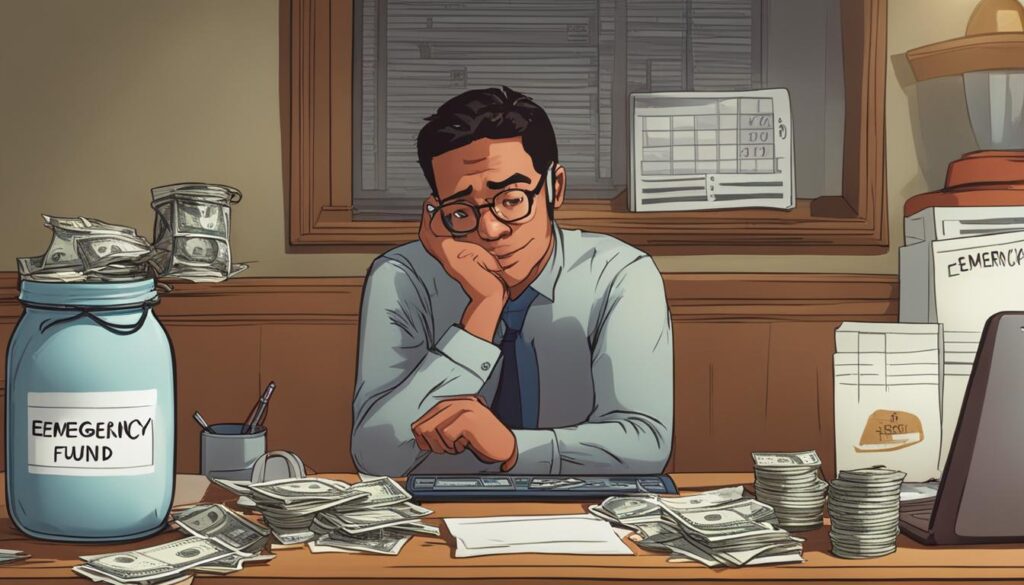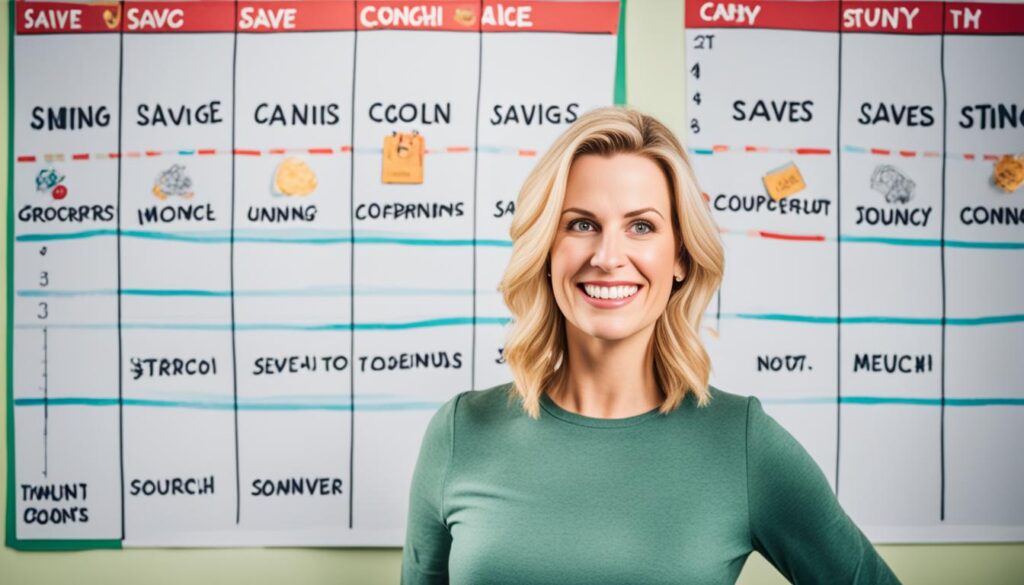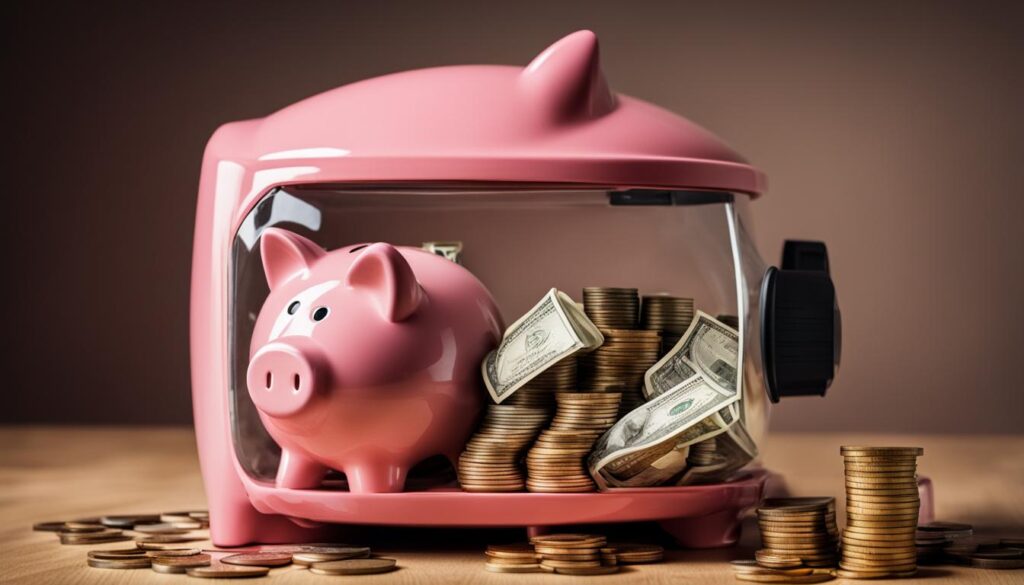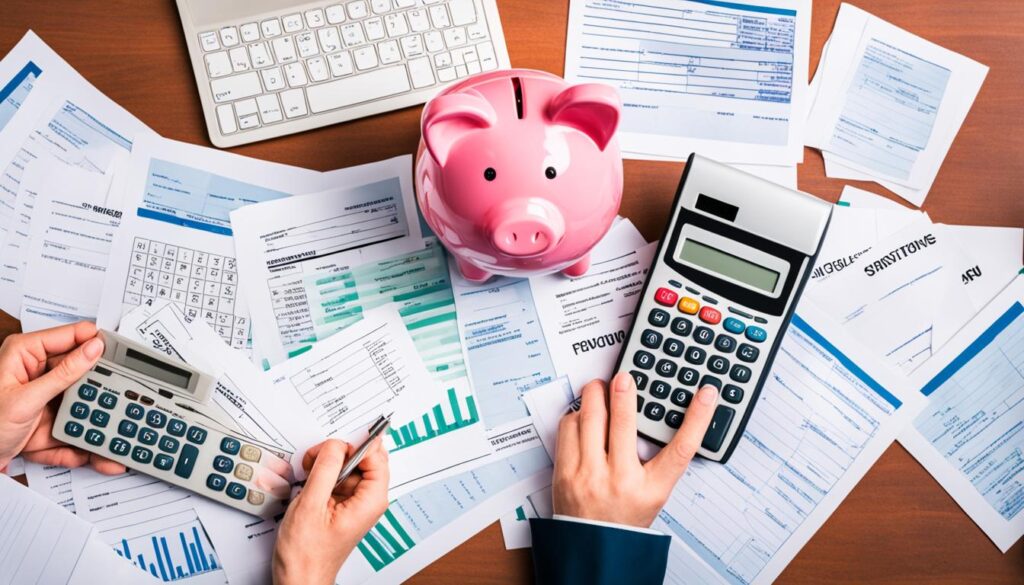When money is tight, setting up an emergency fund might seem hard. But having this safety net for unexpected costs is vital. You can make an emergency fund with smart steps. This will keep you safe financially when things get tough.

Key Takeaways:
- Saving money during emergencies is essential for financial stability.
- Financial planning for emergencies involves budgeting for unexpected expenses.
- Emergency fund strategies can help you build savings on a tight budget.
- Managing finances during crises requires the establishment of an emergency fund.
- By preparing for financial emergencies, you can avoid falling into debt and maintain peace of mind.
Set Reasonable Savings Goals
Starting small with your savings goals can lead to big changes. Don’t set lofty targets at first. Instead, focus on small, achievable milestones. This method makes your goals more reachable. It also keeps you motivated to save more.
Begin by saving for one month’s worth of expenses. It’s a realistic goal that lays the groundwork for your emergency fund. After reaching this goal, aim higher gradually. You can save for three months of expenses or decide on a specific dollar amount. The important thing is to keep raising your goal, but it should always feel achievable.
Breaking your savings journey into smaller goals helps keep up your momentum. Each goal you achieve is a reason to celebrate. It motivates you to continue. With time, saving becomes a regular part of your financial habits.
Financial security doesn’t happen overnight. Setting reasonable savings goals helps you progress at a steady pace. This way, you create a saving habit that lasts.
Milestone Savings Goals
| Savings Milestone | Amount to Save |
|---|---|
| One month’s expenses | $1,500 |
| Three months’ expenses | $4,500 |
| Six months’ expenses | $9,000 |
| Specific dollar amount | $10,000 |
Start with Small, Regular Contributions
Building an emergency fund starts with small steps. You don’t have to begin with a lot of money. Set up a regular savings plan you can keep up. This way, your emergency fund grows steadily without stressing your budget.
Choose an amount to save regularly that feels easy for you. It might be $5 or $10 weekly, or a part of your monthly earnings. The goal is to make saving something you can do without feeling stressed.
To save this money, look at cutting back on small expenses. Review your spending to see where to save, like making lunch at home or stopping unnecessary subscriptions.
Automating your savings can also help. Arrange for your bank to move money from your checking to your savings account routinely. This makes saving effortless and a part of your financial habits.
Developing the habit of saving is as crucial as how much you save. Starting with small, consistent contributions builds a strong emergency fund over time.

Benefits of small, regular contributions:
- Consistency: Regular contributions help you create a disciplined savings routine.
- Manageability: Beginning with small amounts lets you save within your budget and adjust as needed.
- Finances in control: Cutting costs and saving regularly means you manage your money well, ready for any surprises.
- Peace of mind: A growing emergency fund offers financial security and peace of mind.
Automate Your Savings
Automating your savings is a great way to grow your emergency fund. By setting up automated contributions, you don’t have to remember to transfer money each month. This ensures your savings consistently build over time.
_”Automating your savings is like putting your finances on autopilot. It takes away the hassle and makes saving a seamless part of your financial routine.”_
The first step is to open a separate savings account just for your emergency fund. This keeps your savings away from your daily spending. It also helps you avoid using those funds for non-emergencies.

With your separate savings account ready, it’s time to set up automatic transfers. You have two main ways to do this:
Direct Deposit:
You can save directly from your paycheck if your employer offers direct deposit. This method allows you to save money without even thinking about it.
Automatic Transfers:
If direct deposit isn’t an option, or you have other sources of income, automatic transfers are your go-to. You decide how much money and how often it moves to your emergency fund. It could be weekly, bi-weekly, or monthly.
_”Automating your savings ensures that your contributions are consistent and regular, making it easier to reach your emergency fund goal.”_
Automating your savings also keeps you from spending that money. Since the funds go into a separate account, you’re less likely to use them on a whim. This helps you stick to your goal of building an emergency fund.
Automating your savings lets you grow your emergency fund with ease. It removes the need for manual transfers. This is a smart, reliable way to ensure financial security against unexpected expenses.
| Benefits of Automating Your Savings |
|---|
| Consistency: By automating your savings, you ensure regular contributions, making it easier to build your emergency fund. |
| Reduced Temptation: Keeping your savings separate and out of sight reduces the temptation to spend the money on non-emergency expenses. |
| Convenience: Once set up, automated savings require little to no effort, allowing you to focus on other aspects of your financial journey. |
| Peace of Mind: Knowing that your emergency fund is steadily growing gives you financial security and peace of mind. |
Avoid Increasing Monthly Spending
Having a saving routine is vital. But, it’s just as important to watch your monthly spending. Avoid lifestyle inflation and credit card debt. These steps are crucial to keep your savings growing.
When you start earning more, resist spending more. It might tempt you to get a fancier car or a bigger house. These upgrades can chip away at your savings. Aim for a lifestyle that matches your financial targets instead.
Be wary of credit card debt. It’s easy to overspend using credit cards for things you can’t afford. This habit can lead to debt that’s hard to escape. Stick to using cash or a debit card to stay on budget.
Check your budget and track spending regularly. Look for ways to cut back. This might mean eating out less or cancelling unused subscriptions. It’s a good way to boost your savings.

“The temptation to spend will always be there, but by staying committed to your financial goals and maintaining discipline, you can make smart choices that support your long-term financial well-being.”
The Benefits of Maintaining Financial Discipline
Avoiding lifestyle inflation and credit card debt has many long-term benefits:
- Preserving Your Emergency Fund: By cutting unnecessary spending, your emergency fund stays safe. It’s a key safety net during financial trouble.
- Building a Strong Financial Foundation: Keeping financial discipline helps build a stable future. This base supports goals like home buying or saving for retirement.
- Avoiding Stress and Anxiety: Good financial habits lessen money-related stress and anxiety. This can improve your overall mental and emotional health.
- Setting a Positive Example: Staying disciplined with finances sets a good example for others. Your responsible habits can motivate friends and family to do the same.
Maintaining financial discipline is a continuous journey. It needs self-awareness, persistence, and dedication to your financial goals. By avoiding traps like lifestyle inflation, you can stay on track towards financial security and keep your emergency fund safe.
| Benefits of Maintaining Financial Discipline | |
|---|---|
| 1 | Preserving your emergency fund |
| 2 | Building a strong financial foundation |
| 3 | Avoiding stress and anxiety |
| 4 | Setting a positive example |
Don’t Over-Save
It’s key to balance how much you save and how easily you can use your cash. Too much in your emergency fund might stop you from growing your savings. This fund should let you quickly get cash when you need it.
After hitting your savings target, think about putting extra money into investments like retirement accounts. This way, your savings can increase their value over time. You make sure your money works for you by investing wisely.
Investing the Excess Savings
Look for investments that fit your goals and how much risk you can take. Explore stocks, bonds, mutual funds, or ETFs to build wealth. If uncertain, get advice from a financial advisor to make smart choices.
Investing wisely is part of a strong financial plan. Spread out your investments to lower risk. Even as you invest more, keep your emergency fund balanced. Make sure it’s not too little or too much.
“By investing your excess savings wisely, you can take advantage of opportunities and potentially earn higher returns than traditional savings accounts.” – Financial Advisor, John Smith
Regularly check your emergency fund’s size. Changes in your life like income, family size, or job can change how much you should save.

Investing extra savings is crucial for growing your wealth and reaching financial goals. With careful planning and wise investments, you’ll find the perfect mix between a good emergency fund and growing your money.
The Importance of an Emergency Fund
Having an emergency fund is key to staying financially secure. It acts as a safety layer, stopping you and your family from falling into debt during surprises. This buffer zone offers calm, knowing you’re ready for any financial emergencies.
This fund is your safety net in uncertain times like losing a job, health issues, or sudden house repairs. Instead of using credit cards with high interest, a good emergency fund lets you handle costs. You don’t need to gather more debt. This way, you can tackle financial surprises confidently.
Having this fund also means peace of mind. It gives you a sense of security and steadiness. This removes the worry tied to unexpected bills, letting you focus on other life areas. With an emergency fund, you rest easy at night, prepared for any challenge.
An emergency fund is vital for your financial plan. It’s the base for a stronger financial future. Starting and keeping an emergency fund puts you on the path to success. It helps you follow your financial dreams, steer clear of debts, and find financial peace.

Benefits of an Emergency Fund
| Benefits | Description |
|---|---|
| Financial Security | Protects against unexpected expenses and provides stability during times of crises. |
| Debt Avoidance | Helps avoid accumulating debt by providing funds for emergencies without relying on credit cards or loans. |
| Peace of Mind | Brings a sense of security, reducing stress and anxiety associated with unexpected financial challenges. |
| Strong Financial Foundation | Provides the basis for a solid financial plan and enables long-term financial success. |
The Role of an Emergency Fund in Managing Financial Crises
In times like job loss or health issues, an emergency fund acts as a lifesaver. It helps you manage these crises without depending on loans or credit cards. Having this fund makes tough times easier and less worrisome.
This fund is your financial safety net for unforeseen events. Whether it’s surprise medical costs or losing your job, it keeps you afloat. You can cover essential expenses without going into debt or selling off assets.
“Building an emergency fund before a crisis occurs is like buying insurance for your finances. It provides a cushion that allows you to weather financial storms without causing lasting damage to your financial health.”
In crisis moments, staying financially stable is crucial as it calms your mind. An emergency fund is your quick cash source for urgent situations. With a strong fund, you face challenges boldly, knowing your back’s covered.
Benefits of an Emergency Fund in Managing Financial Crises
Having an emergency fund is key in crisis times:
- Financial Security: You feel secure with a fund set for sudden needs. This way, you don’t lean on loans or rack up debt.
- Peace of Mind: Knowing you’re ready for any financial emergency reduces stress and worry.
- Flexibility: This fund allows you to make smart choices without haste or pressure.
- Reduced Dependency: You avoid the trap of high-interest financing, keeping you financially free.

Starting an emergency fund is a smart move. It stabilizes your finances, eases your mind, and supports you through hard times. By focusing on building and maintaining it, you’ll weather financial storms with confidence and bounce back stronger.
Determining the Right Amount for Your Emergency Fund
Building an emergency fund is essential for financial security. Determining the right amount can be challenging. The ideal size depends on your income, dependents, and job stability.
Calculate Your Emergency Fund Needs
Start by evaluating your monthly essential expenses. This includes housing, utilities, transportation, food, and debt payments. Add these up to know how much you need for a few months.
A general rule is to save three to six months’ worth of expenses. If your job is stable with steady income, saving for three months might be enough.
Those with dependents or unstable jobs should aim for a larger fund. Saving six months’ worth of expenses provides more security. It helps you stay calm during hard times.
Factors Affecting Fund Size
Several factors can change the size of your fund. Let’s look at what can impact how much you should save:
- Income: If you have a high income, you might need a larger fund. Think about how long finding a new job could take.
- Dependents: Having dependents means you need to save more. Think about their extra expenses.
- Job Stability: Unstable jobs require a larger fund. This gives you a safety net.
- Health and Insurance: Check your health and insurance. This helps gauge unexpected medical costs.
By looking at these factors, you can figure out a realistic fund size. This ensures you are prepared.

Building a fund takes time. It’s okay to start small and increase as you can. Consistency is key. This way, you protect yourself and loved ones from financial surprises.
| Factors Affecting Emergency Fund Size | Considerations |
|---|---|
| Income Stability | The more stable your income, the smaller the fund you might need. |
| Number of Dependents | The more dependents you have, the larger your emergency fund should be. |
| Job Stability | Higher job instability or irregular income means you need a larger fund. |
| Health and Insurance Coverage | Consider potential unexpected medical costs and insurance coverage. |
Choosing the Right Account for Your Emergency Fund
When creating an emergency fund, picking the right savings account is key. Look for a high-yield savings option with competitive interest rates. These accounts boost your savings. Online banks might be best since they offer high yields and low fees.
Being able to get to your money easily is critical. In an emergency, quick access is a must. Make sure your chosen account allows for fast withdrawals, using online transfers or ATMs.
Keeping your money safe should be a top priority. Go for accounts that are FDIC-insured or NCUA-insured. This way, you know your money is safe up to specific limits if the bank fails.

Choose a high-yield savings account that’s easy to access and insured. This will help keep your emergency fund secure and ready whenever you need it.
Steps to Get Your Emergency Fund Started
Starting your emergency fund begins with creating a budget. Understanding your expenses is key. This lets you find ways to save money. Then, you can put those savings aside.
Next, figure out how much you need to save. Look at your monthly costs, like rent and groceries. Set a savings goal that feels possible for you.
Using direct deposit makes saving simple. You can have part of your income go straight into your emergency fund. This automatic approach helps you save without thinking about it.
Try to save more over time. Begin with small amounts. Then, slowly increase your savings each month. Your emergency fund will grow stronger this way.
Save any extra money you get, like tax refunds or bonuses. Treat this money as part of your emergency fund, not for spending. Keep saving even after you reach your goal. This keeps your fund solid.
Building a good emergency fund means budgeting, setting a goal, using direct deposit, increasing savings, and saving bonuses. These steps create a financial safety net for you. It gives you security and confidence to handle surprises.